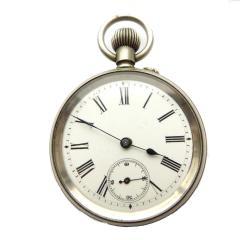-
Recently Browsing
- No registered users viewing this page.
-
Topics
-
Posts
-
By nevenbekriev · Posted
OK, welcome in the world of alarm clocks... I guess the 4th wheel is dished because it is from another movement. If it was not dishet, then it would not mesh with the pinion of the escape wheel, am I right? The marks of wear on the 4th wheel pinion doesn't corespond to the 3th wheel table position, at list this is what i see on the picts. Calculating the rate is easy - there is a formula - BR = T2 x T3 x T4 x T5 x 2 /(P3 x P4 x P5) where T2 - T5 are the counts of the teeth of the wheels tables, and P3 - P5 are the counts of the pinion leaves. Vibrating the balance is easy - grasp for the hairspring where it should stay in the regulator with tweasers, let the balance hang on the hairspring while the downside staff tip rests on glass surface. Then make the balance oscillate and use timer to measure the time for let say 50 oscillations, or count the oscillations for let say 30 seconds. You must do the free oscillations test to check the balance staff tips and the cone cup bearings for wear. This kind of staffs wear and need resharpening to restore the normal function of the balance. -
By RichardHarris123 · Posted
Glue a nut to the barrel lid, insert a bolt, pull, disolve the glue. Maybe someone will have a better answer. -
The stress is the force (on the spring) x distance. The maximum stress is at the bottom, and decreases up the arm. That's why they always break at the bottom. I used a round file, then something like 2000 grit to finish. I gave the rest of the arm a quick polish - no need for a perfect finish. Just make sure there are no 'notches' left from cutting/filing. The notches act like the perforations in your toilet paper 🤣
-
It's probably a cardinal rule for watch repair to never get distracted while at the bench. Yesterday, after finishing a tricky mainspring winding/barrel insertion (I didn't have a winder and arbor that fit very well) I mentally shifted down a gear once that hurdle was passed. There were other things going on in the room as I put the barrel and cover into the barrel closer and pressed to get that satisfying snap. But when I took it out I realized I never placed the arbor. When opening a barrel, we are relying on the arbor to transfer a concentrically-distributed force right where it is needed at the internal center of the lid. However, when that isn't present it's difficult to apply pressure or get leverage considering the recessed position of the lid, the small holes in the barrel and the presence of the mainspring coils. It was a beat-up practice movement so I didn't take a lot of time to think it over and I pushed it out using a short right-angle dental probe placed in from the bottom, but that did leave a bit of a scratch and crease in the thin lid. I had also thought about pulling it using a course-threaded screw with a minor thread diameter smaller than the lid hole and a major diameter larger, but that may have done some damage as well. Thinking about how this might have been handled had it been a more valuable movement, is there a method using watchmaking or other tools that should extract the lid with the least damage?
-
By Neverenoughwatches · Posted
🤔 what happens if lubrication is placed directly on top of epilame ? Making a small groove so the lubrication doesn't spread across the component but what if when lubing a little overspills and sits on the epilame .
-








Recommended Posts
Join the conversation
You can post now and register later. If you have an account, sign in now to post with your account.
Note: Your post will require moderator approval before it will be visible.